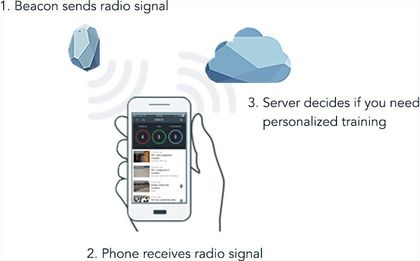How Geofencing Can Revolutionize Your On-The-Ground Employee Training
Michael Hansen
🍿 4 min. read
Picture this: you need to figure out how to effectively design and deliver on-the-ground employee training, but the fact that many of your employees are often out in the field makes this a challenge. You already know about microlearning and have developed multiple small bites of training to be accessed by employees, but they only need parts of it at certain times and in certain locations. The next-level training solution for this highly-dispersed and mobile workforce? Geofencing.
What is a geofence?
A geofence is an electronic boundary placed around a particular area. Right now geofencing is used primarily in marketing and retail to attract customers. Businesses use radiofrequency identification to set up a perimeter in a zip code, around a neighborhood, within a store, or even surrounding an entire town. The more densely-populated an area is, the smaller the geofence can be. For example, an urban location would use a smaller geofence than a rural business.
In today's use, when a potential customer enters the geofence, the business sends a coupon or a sales alert to their cellphone via a push notification.
Geofencing also makes tracking customers easier for businesses. The geofence can glean information about how long a potential customers lingers inside its boundaries, how often they visit, and at what times. Targeting your message to this real-time data can make for highly effective use of geofencing applications and push notifications for sales.
However, while it may have started as a sales technique, geofencing has real potential in revolutionizing training and recruitment efforts.

How does geofencing for recruitment work?
Geofencing isn’t just for sales and marketing anymore. Increasingly, tech savvy businesses are using a geofence for recruitment and training.
Take, for example, the shortage of specialty nurses in one Florida city. Johns Hopkins All Children's Hospital in St. Petersburg was struggling to staff its acute-care neonatal unit. To solve this problem, they set up a geofence and looked for qualified nursing staff online. When potential nurses entered the geofenced area they received a push notification to apply for a job.
The result? An increase in job applications from none to three or four every week.
What about geofencing for employee training?
Expanding even further, say you are a company that sends employees out into the field or a jobsite everyday. A geofencing application could be designed to send out a push notification with a reminder to check for compliance or safety updates that are delivered as a two-minute video to employees.
The push notification is an important part of geofencing. Although both texts and push notifications have a 90% open rate, push notifications have a higher opt-in rate than text messages. Other advantages include:
- Push notifications are free: Geofencing alerts shouldn’t cost you money
- Opt in/opt out means more engagement: The more that people interact with your app, the more likely they are to take an action
- Push notifications are easily personalized: Texts have this feature also, but “opt-in” users are already saying yes, which means they want to hear more
Want more examples? In hospital settings, a geofence beacon can be set for patient updates in small areas. Doctors and nurses entering each ward can get push notifications to check on patient updates or urgent alerts.
Utility workers can receive notifications on the areas for utility wires, underground pipes, and other infrastructure when they enter a geofence to work. Newly-hired construction workers can take on-the-ground assessments to make sure they understand safety regulations for their first day on the job.
With more employees working from home, some companies are also using geofencing applications to remind employees to clock in and out electronically. Contrary to what you might think, the majority of employees who clock in and out after geofencing alerts have a positive feeling about it.
What geofencing apps are available for training?
These innovative uses for geofencing are great, but with newer training technology it's often challenging to find quality tools.
Thankfully, PinPoint Workforce is one of the leading providers of mobile-first geofence training apps. They offer key training capabilities for safety training, employee onboarding, operating procedures, field support, and many other training areas. Their geofencing apps are designed for many different industries. Many of these tools can be customized in areas as small as 32 feet, expanding all the way out to just under a mile radius. Using the app to develop your courses is also easy.
What's the future of geofencing for training?
GPS tracking is not a new technology, but geofencing for workforce training has huge potential.
While compliance, operating procedures, and checklists may not be life-and-death, putting these tools into your employees’ hands exactly when they need them can be the difference between a company with an innovative and safe workforce and one that is left thumbing through a manual back at the office. Training delivered in theory will never be as valuable as training that can be immediately put into practice.
Geofencing can also make the best use of the average 24 minutes a week employees typically have for training by delivering just-in-time information when they need it most.
If you want to see how location-aware geofencing can revolutionize the way you train your employees, give the team at EdgePoint Learning a call.
